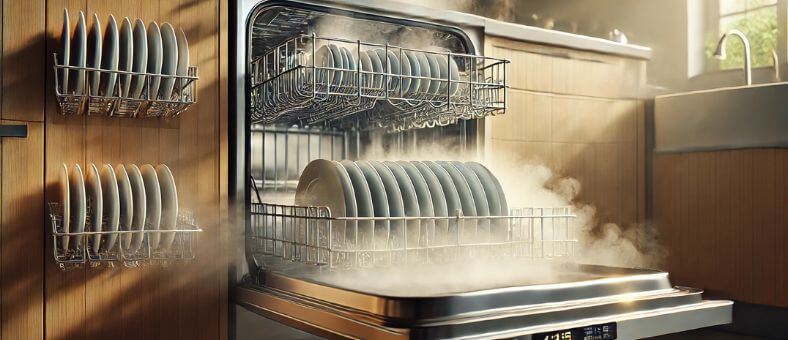In today’s age of convenience, dishwashers have become an indispensable part of our kitchens. Beyond saving time and effort, they bring another significant advantage — the ‘Sanitization Function in Dishwashers.’ This remarkable function, now a feature of most modern dishwashers, ensures your dishes go beyond being merely clean to being thoroughly sanitized.
‘Sanitization Function in Dishwashers’ utilizes high-temperature water to eradicate bacteria, offering your household an added layer of protection. By understanding the crucial role and the effectiveness of the ‘Sanitization Function in Dishwashers,’ you can ensure a healthier and safer kitchen environment.
Evolution of Sanitization in Dishwashers
The sanitization function is a relatively modern addition to dishwashers, only beginning to appear in models from the late 20th century. This feature significantly enhanced the efficiency and effectiveness of dishwashers.
Table of Contents
How Does the Sanitize Cycle Work in Dishwashers?

The Sanitize cycle in a dishwasher works by elevating the temperature of the final rinse water to a point where it can kill off bacteria on your dishes. The U.S. National Sanitation Foundation (NSF) specifies that the dishwasher must reach at least 150°F (65.55°C) during sanitizing to effectively kill bacteria. By maintaining this temperature for a specific duration, dishwashers can reduce 99.999% of bacteria, providing a higher level of cleanliness.
Benefits of Using the Sanitize Cycle
The sanitizing cycle provides numerous benefits. Primarily, it ensures a deeper level of cleanliness by eliminating bacteria that regular washing might only partially remove. This function is handy in households with children, with children, older people, or individuals with weakened immune systems, where maintaining a bacteria-free environment is crucial. Using the sanitizer cycle can also be helpful during flu season or if a family member is ill, as it can aid in preventing the spread of germs.
When Should You Use the Sanitize Cycle?
The sanitization cycle should not be considered a daily necessity for most households. It uses more energy due to its high-temperature rinse cycle, making it less energy-efficient than regular cycles. However, there are instances where using it can be beneficial. Apart from the cases mentioned above, it can be helpful if you’re washing dishes sitting in the dishwasher for a few days or using second-hand kitchenware for the first time. It can also be beneficial when preparing for large gatherings, as it assures your guests of sanitized dishes.
Steps for Utilizing the Sanitize Cycle in a Dishwasher
Using the sanitizing cycle in a dishwasher is straightforward and requires no additional supplies. Here are the simple steps:
Load the Dishwasher
Start loading your dishwasher as you normally would. Ensure the dishes are evenly distributed and not overlapping to allow the water to reach all areas.
Choose the Right Cycle
Select the sanitize cycle on your dishwasher’s control panel once loaded. It may be labeled as “Sanitize,” “High Temp,” or “Steam Sanitize,” depending on the model of your dishwasher.
Add Detergent
Add your regular dishwasher detergent. The sanitizing cycle does not require any special cleaning agents.
Start the Cycle
Once you’ve selected the sanitized cycle and added your detergent, you can start the cycle. The dishwasher will then wash at a higher temperature to eliminate bacteria.
Does the Sanitize Cycle Use More Energy?
The sanitizing cycle does indeed use more energy than the regular wash cycle. This is because the water needs to be heated to a higher temperature (at least 150 degrees Fahrenheit) to ensure the elimination of bacteria. The dishwasher also runs for a longer time, which further increases energy consumption. However, it’s worth mentioning that most dishwashers are designed to be energy-efficient, and the additional cost of using the sanitizing cycle is typically minimal.
Quantity Matters
Running a full load in a dishwasher uses 1/6 less water than hand washing the same dishes, even with the sanitize cycle on.
Safety Concerns with the Sanitize Cycle

While the sanitizing cycle is designed to be safe for use, there are a few factors to consider. First, the high-temperature wash may not be suitable for certain dishes, such as plastic ware or delicate items, as the heat could cause them to warp or crack. Always check the manufacturer’s instructions for each item before using this cycle. Additionally, the dishwasher door can be extremely hot to the touch during and immediately after the sanitizing cycle. Be cautious when opening the dishwasher after the cycle is complete to prevent potential burns.
Understanding Different Cleaning Cycles: Sanitize vs. Antibacterial
Many dishwashers offer both a sanitizing and an antibacterial cycle, so understanding the difference is important. While both cycles aim to eliminate bacteria, they do so in different ways and varying degrees.
The sanitizing cycle uses high heat to kill bacteria and to be certified as a sanitizing dishwasher by the National Sanitation Foundation, the dishwasher must remove 99.999% of bacteria. On the other hand, the antibacterial cycle, a term often used by manufacturers, also aims to kill bacteria, but it might not meet the stringent criteria of the sanitization cycle. In addition, the antibacterial cycle may use other means, such as a hot rinse or an extended heat cycle, to kill bacteria.
Dishwasher sanitization vs. hand washing
Efficiency in Removing Bacteria
Dishwashers, particularly those with a sanitization cycle, are typically more effective at killing bacteria on dishes. The high temperatures reached in the sanitization cycle (around 150-165°F) can kill nearly 99.99% of bacteria, which is a level of cleanliness hard to achieve with hand washing.
Energy and Water Usage
Dishwashers, especially modern, energy-efficient models, often use less water than washing dishes by hand. They can also save on energy by heating only the water used, unlike hand washing, where you might heat a large amount of water but use only a portion.
Consistency
A dishwasher provides consistent cleanliness as it follows the same process each cycle. With hand washing, the effectiveness can vary based on factors like how thorough the person is, how hot the water is, and the type of detergent used.
Time Efficiency
Dishwashers save time compared to hand washing. While the cycle might take longer than hand washing a load of dishes, the time the user needs to spend is much less as the machine does the work.
Gentle on Hands: Hand washing with hot water and dish soap can be harsh on the skin over time. Using a dishwasher eliminates this concern.
Drying Efficiency
Dishwashers often have a drying cycle that uses heat to effectively dry dishes, reducing the risk of bacterial growth from standing water. With hand washing, dishes must be dried manually or left to air dry.
Protection of Delicate Items
Hand washing is better for delicate items that could be damaged in a dishwasher. However, many modern dishwashers have light or glassware cycles designed to clean fragile items safely.
Difference Between Sanitizing and Sterilizing
While sanitizing and sterilizing are often used interchangeably, they do not mean the same thing. Sanitizing refers to reducing the number of bacteria, viruses, and other microorganisms to a safe level. It doesn’t necessarily eliminate all microorganisms but lowers their number to a level deemed safe by public health standards.
Sterilizing, conversely, refers to eliminating all forms of microbial life, including bacteria, viruses, spores, and fungi. This is usually done using extreme heat, chemicals, or radiation. In the context of a dishwasher, while the sanitizing cycle can effectively reduce the number of bacteria to a safe level, it doesn’t completely sterilize the dishes.
Do dishwashers get hot enough to sterilize?

Most household dishwashers, even those with a sanitizing cycle, do not reach temperatures high enough to sterilize dishes. Sterilization typically requires sustained extreme heat that is impossible in a standard home dishwasher. Autoclaves are usually used for sterilization, reaching temperatures over 250 degrees Fahrenheit, well beyond what a household dishwasher can provide.
However, the sanitizing cycle gets hot enough to significantly reduce the number of bacteria on dishes, making them safe for most purposes. For items needing sterilization, like baby bottles or medical equipment, you would need to use a method designed explicitly for sterilization.
Tips for Maximizing the Effectiveness of the Sanitize Cycle
Here are some key strategies to maximize the effectiveness of your dishwasher’s sanitizing cycle:
Maintain Your Dishwasher for Optimal Performance
It’s essential to regularly check your dishwasher to ensure its optimal performance. Maintenance tasks, such as cleaning the filter and spray arms, are integral to the overall effectiveness of your dishwasher. This proactive approach boosts the appliance’s efficiency and extends its lifespan.
Properly load the dishes
Make sure that the dishes are not overcrowded to allow hot water to reach all surfaces. Heavily soiled items should be placed on the bottom rack, where they will receive stronger sprays.
Use suitable detergent
Consider the type of detergent you use. Detergents specifically designed to work in high-temperature wash cycles can boost the sanitizing effect.
The Role of Detergent in the Dishwasher’s Sanitize Cycle
Detergent plays a critical role in the sanitization process of your dishwasher. It works in tandem with the high heat of the sanitizing cycle to effectively remove food residue and kill bacteria. The alkalinity of the detergent helps to break down food particles and grease. At the same time, the bleach component aids in eliminating stains and sanitizing your dishes.
Additionally, detergents designed for high-temperature cycles can enhance the effectiveness of the sanitizing cycle. These detergents are formulated to remain stable at high temperatures, ensuring a thorough clean even during the intense sanitizing cycle.
Suitable Items for the Dishwasher’s Sanitizing Option
While the sanitizing cycle is an excellent feature for ensuring your dishes are clean and bacteria-free, not all items are suitable for this intense cycle. Items that can typically handle the high temperatures of the sanitizing cycle include metal utensils, pots and pans, and most ceramic or porcelain dishes.
However, plastic items, non-heat-resistant glass, and delicate items may not withstand high temperatures. They could warp, crack, or suffer other damage. Always check the manufacturer’s instructions for each item before using the sanitizing cycle. If in doubt, it is safer to hand-wash delicate or heat-sensitive items.
Crystal Clear Warning
Despite their durability, crystal glasses can turn cloudy or damaged when exposed to the dishwasher’s sanitizing heat. Always hand-wash these delicate items!
Wrapping Up: The Sanitization Function in Dishwashers
Understanding the sanitization function in dishwashers can be a game-changer in maintaining a clean and hygienic kitchen environment. This in-depth exploration of the sanitizing cycle, from its operational mechanisms to its distinct advantages, highlights its importance in eliminating harmful bacteria and ensuring safe dishware. Moreover, recognizing when to utilize this cycle and how to enhance its efficiency can contribute to better energy management, ultimately aiding in creating an eco-friendly household.
So whether it’s deciphering the differences between sanitizing, antibacterial, and sterilizing cycles or acknowledging the roles of energy usage and detergent selection, this comprehensive guide serves to aid every homeowner in maximizing their dishwasher’s potential. Armed with this knowledge, you can confidently harness the power of your dishwasher’s sanitizing cycle for a healthier, cleaner home.
To complement your understanding of dishwasher sanitization and enhance your kitchen setup, consider these top countertop dishwashers with sanitization functions:
Explore our selection of top-rated countertop dishwashers featuring advanced sanitization functions to ensure your dishes are not only clean but hygienically safe.
- Hermitlux HDW5CW01 Dishwasher Review
- SEAGTOM TDQRO9 Dishwasher Review
- HAVA TDJR09 Dishwasher Review
- AIRMSEN A01 Dishwasher Review
At WashDryDazzle, we’re dedicated to providing essential insights that make your daily chores effortless. Dive deeper into our comprehensive Dishwasher Education hub to learn more.
Frequently Asked Questions (FAQs)
Does the sanitizing cycle kill all bacteria and viruses?
The sanitizing cycle is designed to kill many harmful bacteria, generally 99.99% when used correctly. However, it’s important to note that no process is 100% effective, and there may still be some pathogens that survive. Additionally, this cycle may be less effective against certain types of viruses.
Can I use the sanitize cycle for items other than dishes?
Yes, many items can be sanitized in the dishwasher, but it’s essential to check the item’s care instructions first. Objects such as glass jars, toys, and certain metal utensils can often be sanitized in the dishwasher. Always avoid placing items that can be damaged by heat, such as certain plastics, in the dishwasher.
What temperature does the sanitizing cycle reach in a dishwasher?
The exact temperature can vary by dishwasher brand and model, but in general, the sanitizing cycle usually reaches temperatures of around 150°F to 165°F, which is significantly higher than regular wash cycles.
Does the sanitizing cycle damage delicate items?
The sanitizing cycle uses higher temperatures, which could potentially damage delicate items. It’s best to avoid using this cycle for delicate glassware, certain plastics, or other items that may be sensitive to high heat.
Is it necessary to use a special detergent for the sanitizing cycle?
While you can use regular dishwasher detergent, some detergents are specifically designed for high-temperature cycles. These can enhance the cleaning and sanitizing effectiveness of the cycle. Always refer to your dishwasher’s user manual for detergent recommendations.
Is there any risk of dishwasher damage when using the sanitizing cycle frequently?
No, using the sanitizer cycle regularly should not harm your dishwasher. However, as with any appliance, regular maintenance is key to keeping it in good working order. Always ensure that your dishwasher is clean and well-maintained, irrespective of your wash cycle.
How long does the sanitizing cycle usually take?
The length of the sanitizing cycle can vary depending on the model of the dishwasher. Generally, it can take anywhere from 1.5 to 2 hours. Check your dishwasher’s manual for precise timings.
Can I sanitize baby bottles in the dishwasher?
Yes, many baby bottles are dishwasher-safe and can be sanitized in the dishwasher. However, it’s always best to check the care instructions on the baby bottles to ensure they can withstand the high temperatures of the sanitize cycle.
What’s the difference between “Sanitize” and “Steam Sanitize” in dishwashers?
The “Sanitize” cycle uses high heat to kill bacteria, while the “Steam Sanitize” option combines this with steam. The steam helps to loosen food debris and enhances sanitizing, but it may also increase the cycle time.
How do I know if my dishwasher has a sanitizing cycle?
Most modern dishwashers come equipped with a sanitized cycle. Check your dishwasher’s control panel for a “Sanitize” option. For more clarification, refer to your dishwasher’s user manual or contact the manufacturer.
Does the sanitizing cycle consume more water?
The sanitizing cycle may consume slightly more water due to the additional heating, and sometimes extra rinsing, but the difference is usually negligible. Most modern dishwashers are designed to efficiently use water, even during the sanitizing cycle.
What are some popular dishwasher models with a sanitization cycle?
Are dishwashers with sanitizing cycles more expensive?
While dishwashers with sanitizing cycles might be priced slightly higher due to the added functionality, the cost can also depend on other factors, such as the brand, model, size, and other features.
Is there a benefit to choosing a dishwasher model with a sanitization cycle?
Yes, a dishwasher with a sanitization cycle can provide additional assurance that your dishes are clean and sanitized. This can be particularly beneficial during cold and flu season or whenever you want to take extra precautions against bacteria and germs.
Do all dishwashers with a sanitization cycle meet NSF/ANSI standards?
Not all dishwashers with a sanitization cycle meet NSF/ANSI standards. If the dishwasher is NSF certified, it has been tested and proven to kill 99.99% of bacteria when the sanitization cycle is used as directed. Look for the NSF logo or certification in the product specifications.
Does the sanitizing cycle take longer than the regular wash cycle?
The sanitizing cycle usually takes longer than the regular wash cycle because it uses higher temperatures to kill bacteria and germs effectively, which requires more time.










